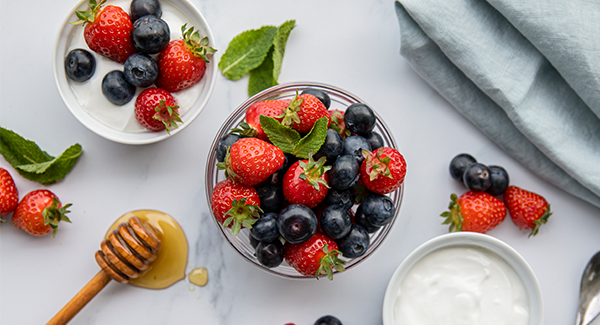How Too Much Sugar Affects Health and How to Cut Back
Added sugars contribute to inflammation and a host of chronic conditions, including autoimmune disease and arthritis. Get tips to avoid them for better overall health.
By Linda Rath | May 28, 2024
Most people in the U.S. eat more sugar than is good for them, including those who have arthritis. Many arthritis symptoms get worse with sugar and other inflammatory foods and improve with healthier eating. Yet it’s hard to avoid added sugar, a main ingredient even in foods marketed as healthy, like yogurt, whole-grain bread and peanut butter.
Decades ago, food companies began an aggressive anti-fat campaign, blaming fat for skyrocketing rates of obesity, diabetes, heart disease and other chronic conditions. Bolstered by flawed science, they began replacing fat with sugar in countless processed foods.
By the early 2000s, most anti-fat claims had been debunked, with some public health officials calling it “the biggest mistake in modern medicine.” Demand for low-fat products dipped for a few years, but started ticking up again, increasing 5% between 2016 and 2021. In surveys, many consumers still say reduced- or low-fat dairy products are better for them.
Meanwhile, sugar is more entrenched than ever in the food supply, occurring in an estimated 74% of packaged foods and drinks. Consumption of sugar-sweetened sodas, which account for nearly half of added sugar in the U.S., increased 500% over the last few decades. According to National Health and Nutrition Examination Survey (NHANES) data, one-third of American adults drink at least one sugary beverage every day. Some teens drink three times that much.
Added Sugar vs. Naturally Occurring Sugar
There are several main types of sugar. All end in the “ose” but they vary in makeup, function and how they’re digested and assimilated.
- Glucose, or blood sugar, is your body’s main energy source. Your digestive system breaks down carbohydrates into glucose, which enters your bloodstream. As glucose levels rise, the pancreas releases insulin, which helps glucose get into cells.
- Fructose. Unlike glucose, fructose is broken down in the liver. It doesn’t cause a rapid rise in blood sugar, but excess amounts can overwhelm the liver, leading to ongoing inflammation, higher triglyceride and cholesterol levels and potentially to liver disease.
- Sucrose, or table sugar, comes from sugar cane. It’s made up of 50% fructose and 50% glucose and is assimilated in both the liver and bloodstream.
- Dextrose is derived from corn or wheat. Like glucose, it raises blood sugar quickly. Dextrose is a food additive used as both a sweetener and preservative.
Added sugar is introduced to food during manufacturing or processing. Lactose (milk sugar) occurs naturally in dairy foods and fructose is a normal part of fruit, some vegetables and honey. Even whole, unprocessed foods can be very sweet. A small mango has 46 grams of sugar; however, unlike added sugars, it is digested slowly and offset by fiber, vitamins, minerals and antioxidants, so natural fructose doesn’t generally cause health problems.
Low- and reduced-fat dairy products are generally higher in lactose because removing fat concentrates the milk sugar and manufacturers often add sugar to boost taste. Plus, recent research shows that whole-fat dairy may be healthier. Contrary to popular belief, it doesn’t contribute to heart disease, weight gain or type 2 diabetes and may help with weight loss by making you feel full longer.
Why Add Sugar?
Added sugar is in more than 600,000 packaged foods on the market. Why? It’s simple economics, says Marion Nestle (no relation to Nestlé foods). Nestle is a former professor of nutrition and respected food industry critic. She notes the enormous profits involved in making and selling processed food and has long been calling out food companies for putting profits ahead of consumer health.
Take high fructose corn syrup (HFCS), a liquid sweetener made from corn starch. It’s cheaper, sweeter and absorbed more quickly than cane sugar. It’s also a leading ingredient in most soft drinks and other processed foods. HFCS has been linked to many health problems and has received a lot of bad press, and some manufacturers are removing it from their products. Sugar isn’t gone, though. It’s still there, sometimes with a different name.
How Much Sugar Is Too Much?
Government guidelines recommend that adults get less than 10% of their daily calories from added sugar. That’s 50 grams or about 12 teaspoons of sugar for people eating 2,000 calories a day. The World Health Organization (WHO) and American Heart Association (AHA) suggest half that amount for adults – 25 grams or 6 teaspoons of sugar – and even less for kids under 18. Children younger than age two shouldn’t have any added sugar.
Very few Americans meet these goals. Most adults, teens and kids in the U.S. get at least 17 teaspoons (68 grams) of added sugar a day. It’s not hard to see why. A 20-ounce bottle of soda contains 16 teaspoons of sugar, nearly three times more than the WHO and AHA recommend and more than government guidelines.
How Does Added Sugar Trigger Inflammation?
Sugar, not fat, sparks the inflammation that drives most chronic diseases, including:
- Obesity
- Heart disease
- Diabetes
- Rheumatoid arthritis (RA)
- Psoriasis
- Multiple sclerosis
- Inflammatory bowel disease
- Liver disease – along with alcohol, high-fructose corn syrup is a leading cause of liver transplants
Added sugar contributes to these and other serious health conditions in several ways:
- It triggers the release of inflammatory cytokines – molecules that signal and activate immune cells. This causes unnecessary inflammation that smolders in the body over time. Chronic, low-grade inflammation damages tissues, which is why it’s associated with so many different conditions. Among other health problems, it’s responsible for the pain, swelling and stiffness that occur with RA and other rheumatic diseases.
- It causes weight gain, especially around the waist, which is associated with cardiovascular disease. Fat pumps out more inflammatory molecules, leading to even more inflammation.
- It leads to the formation of advanced glycation end products (AGEs). These toxic compounds occur in meat cooked at high temperatures, roasted nuts, pasteurized milk and aged cheeses. They can form inside the body, too, when fats and proteins combine with sugar, especially fructose. AGEs have been linked to inflammation, aging, osteoarthritis, sarcopenia (a condition that causes muscle loss) and osteoporosis. They also have been tied to the upswing in chronic inflammatory diseases, including RA.
- It causes inflammation in the digestive tract leading to an unhealthy ratio of “bad” to “good” bacteria and to leaky gut, where damage to the gut lining causes toxins from the intestine to leak into the bloodstream. A growing body of research traces the inflammation driving chronic diseases, including inflammatory and autoimmune forms of arthritis, to problems with the gut microbiome.
What To Cut — and How
Health experts recommend avoiding added sugar as much as possible, including “natural” sweeteners like maple syrup, molasses, honey, agave, malt syrup, maltose, coconut sugar and rice syrup. These aren’t any better for you than any other sugars, like HFCS or sucrose.Changing your eating patterns isn’t easy, but you don’t have to give up fat, count calories or feel deprived to do it. Here are some tips that may help:
Rethink breakfast. For many Americans, breakfast is the sweetest meal of the day. Flavored yogurt, packaged cereals, pastries and many breads (in case toast is your go-to) are loaded with sugar. Instead, try:
- Plain yogurt and add your own fruit and nuts
- Oatmeal, rice porridge or millet with unsweetened nut milk, nut butter or whole milk
- Eggs
- Fruit
- A savory breakfast of rice or flatbread with vegetables or soup, typical in many Asian countries
- Homemade breakfast burritos: flour tortillas filled with eggs, cheese, avocado and hot sauce
- Packaged cereals that don’t have added sugar
- Sugar-free, nitrate-free bacon
Find Soda Alternatives. Giving up sugar-sweetened sodas can be a challenge, especially if you’ve come to rely on the jolt of sugar and caffeine. If you can’t quite quit caffeine, unsweetened coffee and tea are better options. Beware of coffee house drinks, which can contain more than 70 grams of sugar. If you crave fizzy and refreshing, sparkling waters come in dozens of zero-sugar flavors.
Be Careful With Condiments. When you first start eating healthier, you may be tempted to spice up your food with more condiments. The problem is that some commercial condiments contain a lot of added sugar. One tablespoon of ketchup has a teaspoon of sugar from HFCS, and even some imported mustards and salsas aren’t sugar-free.
Let Them Eat…Fruit. If you’re used to a sugary dessert after dinner, try fruit instead, like frozen grapes and cherries or banana ice cream. All you need is a frozen banana and a blender for a creamy, soft-serve style dessert. After blending, you can mix in nut butter, strawberries or unsweetened cocoa powder.
Read Labels (Seriously). Reading labels can be boring, difficult and they may be full of ingredients no one can pronounce. One federal law makes it easier. Manufacturers now have to list the total amount of sugar in a product as well as added sugar. This helps you separate naturally occurring sugar from added sugars.
Try a Seven-Day Sugar Challenge. This can be surprisingly helpful. The idea is to cut all sugar for one week, then see how you feel. Many people miss sugar at first and may even go through a type of withdrawal. But once you stop eating sugar, you generally stop craving it. A sugar vacation doesn’t mean you have to stop eating all sugar forever. Your goal, whether you try the challenge or not, should be to make healthier eating a way of life with no added sugars.

Stay in the Know. Live in the Yes.
Get involved with the arthritis community. Tell us a little about yourself and, based on your interests, you’ll receive emails packed with the latest information and resources to live your best life and connect with others.




_2.jpg?width=600&height=325&ext=.jpg)